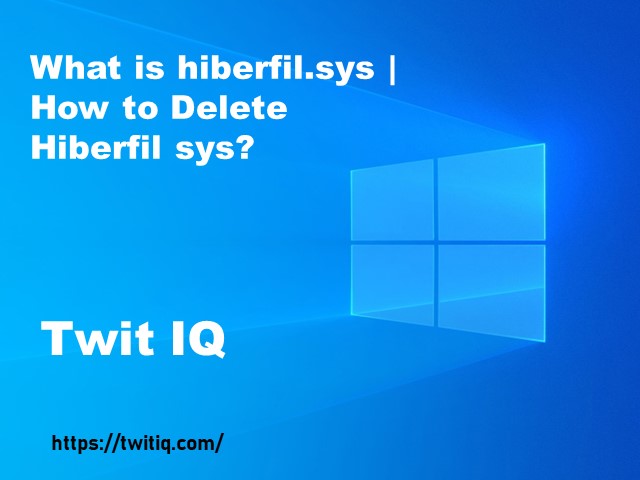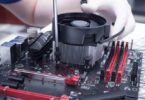In recent times, computers offer a variety of energy-saving options. If you are a laptop user, this feature is very beneficial for you as you can use it on battery power instead of plugging in. The most prominent feature that helps to save power and battery is Hibernate mode. It is also known as Suspend to disk that can turn off your PC. This mode stores the very recent information of the user session to the PC’s hard disk in hiberfil.sys file before closing the OS. Therefore, when you turn on your computer next time from hibernation, you can start your operation from where it was.
If you have any of these Microsoft Windows— Windows 7, 8, or 10, you can see them storing the memory to a file named as hiberfil.sys file that consumes several GBs of space. However, it relies upon the software, system version, and type of device. It is Windows that generates the default memory file, although you never use the Sleep mode. This article discussed how to delete the file, enable, disable, resize, change the size, etc.
What is Hiberfil.sys File?
hiberfil.sys is a system file in Windows OS. The Operating System of your computer stores the current memory content of the system when the system enters into the state of Sleep or Hibernation for power saving. This file will be used to restore the user’s session, when the system boots up from the sleep or hibernation mode. It is a hidden and protected system file of Windows OS.Besides it stored in the hard drive.
When your PC is in hibernation mode, the Windows OS generates it. As it is a hidden file, you can see this in the Windows file manager only. Go to the ‘Show hidden files and folders option to find it. The file becomes very large, i.e., several gigabytes, as it stores all the data. Therefore, you may face storage issues in your device. If you want, you can conserve your computer’s battery power, but it relies upon the version of Windows you have.
Not only can you shut it down, but also you can transfer it into sleep or hibernate mode that consumes less power. Besides, it is accessible to you faster than before. Sleep mode requires only the least power for maintaining the data in the memory of your computer. Compared to that, the Hibernate mode conserves more energy as it writes the data in its memory. The advantage of this mode is that it can bring the PC back up more quickly than bringing it up from a fully off state.
Hibernation Vs Sleep Mode:
It is recommended to use the sleep or hibernation mode rather than turning your PC off. Most of the users generally like to shut down the PC. Hence, you can disable it as the way enables you to remove the file. Thus, you can get the storage space again. Windows keeps the file in the source directory of the system partition in the root directory of C:\ ( a protected OS file).
If you want to see the file size, then follow the steps.
- First, you need to move to the View tab. Then, your job is to choose the Hidden items checkbox.
- After that, your task is to tap on the options. After that, tap on the Change folder option and look for the possibilities.
- When you see the dialog box appearing, your task is to move to the View tab. Then, you have to uncheck the Hide-protected OS files.
Windows 10 desktop PCs can save files, apps both in their memory and hard disk. Then, it goes into a low-power state that makes sure that the document is saved, although a power cut happens. When you enable hiberboot, your computer will save a picture of the Windows kernel and keep it in the file.
As soon as you begin the computer or laptop, the system app loads the file into memory instead of restarting the PC. As a result, it becomes quicker than hibernation. Microsoft has optimized the size of the file to around 40% of the system RAM, whereas the previous size was 95%.
How Does hiberfil.sys Work?
As per the details of online sources, Windows captures a snapshot of your recent OS session after activation of your Windows Hibernate function. It usually takes a snapshot-like any file or program that you have opened. Thereafter, the file will note all the details on the hard drive of your PC. Its use is to shut down your laptop and restart it quickly.
What is Hibernation?
It is one of the power options available in Windows 10. Apart from shutting down, you can keep it in Sleep or Hibernate mode. You can get the best from Sleep mode when you take a short break.
However, hibernate mode doesn’t store the current session in RAM like the Sleep mode. Therefore, there doesn’t exist any risk of losing information in case the battery dies. It saves the documents to the hard drive but is not permanent and then turns off the PC. When you turn your PC into hibernation mode, you can keep your PC unplugged even for a week, and then you can plug back in. It will start the session where you left off.
It is an excellent option for those who don’t want to use their computers for a long time. If you are a laptop user, then it is a good choice for you. Here, you can save your current session, and it ensures you that it is not going to wake up randomly. Hibernate mode doesn’t require constant power for the system to operate.
When you enable the hibernate option, the file is made in the C drive. Generally, the file size is similar to the size of the RAM installed in the system.
Pros of Hibernation:
- It saves the energy of the system.
- There exists a minimum chance of losing data.
- When you don’t have too much time to save your current session, just keep it in hibernation mode. It is because it can open your work where it was.
- When you use the mode on your PC, it behaves like a regular shutdown.
- This model is perfect for systems that consist of limited power batteries.
- It enables you to see an alarm for your battery timing if the battery is going to die. As a result, when the battery remains short, it sends a notification to the user. Therefore, you can turn your system mode into Hibernation mode. Whether you open your work during hibernation mode, your operating system doesn’t use any power.
Cons of Hibernation:
- While you begin the system from hibernation mode, the booting of the system will take a little longer than a normal mode, as, at that moment, all the apps and files remain open.
- This model needs some space on the hard drive, whereas you can get a clear startup shutting down your PC.
Is There Any Option to Hibernate in Windows 10?
Sometimes, you may not get the Hibernate option while clicking the power icon in the Start menu. Here, we have given the steps that you need to follow to enable it.
- First, move to the Settings option. Then, go to the system, power & sleep respectively.
- Then, tap on the Additional power settings for opening the Power Options menu of the Control Panel. You can get it available under the Related settings on the right side.
- After that, you have to tap on the link saying “Choose what the power buttons do.”
- Next, you have to tap on the Change settings option.
- At last, you need to see the Hibernate box for making it enabled on the power menu.
If you want, you may uncheck other different options, but it isn’t so necessary. However, an exception, Fast Startup, can cause slow boot times and other problems.
Enable Hibernate Mode Via CMD:
Use the administrative privileges to open the CMD. Then, your job is to enter this specific “powercfg –h on” command. When you run it, the command disables the Hibernation option from the Start Menu.
Should You Disable Hibernation?
It is pretty easy to erase the file. The only reason you want to disable the file is to save the storage space of the disk. People using a small SSD for their PC can disable their laptop if they don’t use these further. However, if you want, you can try other processes for clearing the space in Windows. If you have a drive with ample storage, then you can use it as it consumes space a maximum of 1-5 percent.
Whether you will not leave your PC all time, you can try the mode to check if it works for you. As you are going to use the mode, you don’t need to close the programs. You don’t need to shut them down if you use these apps the following day.
The mode doesn’t consume additional electricity. You need to know that both Fast Startup and hybrid sleep features are useless if you disable the mode.
Fast Startup assists in booting your PC quickly as it loads a few Windows components before your startup. Thus, it can save some seconds, but it can create issues. You can use the hybrid sleep mode also as it helps the PC to load quickly while coming out of sleep.
To Hibernate or Not:
You know all the things like why you need to disable, whether it is an effective way or not, etc. It is recommended to try this mode to check if it works for you and saves some time. However, whether you require additional disk space, then disable that as you will not get too much advantage from Fast Startup.
How to Disable the hiberfil.sys file in Windows 10:
- First, your task is to open the Command Prompt as admin. After opening, tap on the start menu. Then, type the “cmd.”
- After typing CMD, you can see it popping up in the results. Next, your job is to right-click on that, and after that, open that as admin.
- You need to type the command “powercfg.exe -h off” in the command prompt and then tap on the Enter button.
- At last, turn off the CMD.
We hope that the file is no longer available on your PC. If it still exists, then do this last step.
- Go to the Settings option and open it.
- Then, navigate to the “power settings” option and edit your recently selected power profile.
- You need to search the option “Sleep” in the list and then drop that down. After that, look for the option “Allow hybrid sleep” and drop down for searching the “Plugged in” option. Then, choose the “off” option. If you see this option “On Battery” in the list of your PC, then select it.
- When the file is removed, you will get additional hard drive space similar to the size of the RAM available in your device. It means whether you have a drive of little space 120-240GB or a partition for C:\ & 32GB+ RAM is present, then it is helpful.
Are Sleep and Hibernation Different?
Both of these are different Power modes. It may seem similar to you, but they have different features. Hibernation mode helps save the current session to a file that is available on the hard drive, whereas the Sleep mode saves to the RAM. The combination of these two enables you to restore your session quickly.
How to Make Hibernation Unavailable:
- First, tap on the Windows button that is available on the keyboard. As soon as you tap on it, the Start menu or Start screen will open.
- Then, you have to find the cmd option. Go to the search results list and then right-click on the Command Prompt option. After that, your task is to choose the Run option as Administrator.
- Then, choose the Continue option after being prompted by User Account Control.
- After that, your job is to enter the command powercfg.exe /hibernate off at CMD. Now, hit the Enter button.
- At last, you need to tap on the Exit option. Hit the Enter button for turning off the Command Prompt window.
How to Make Hibernation Available:
In this case, all the steps are similar to before. You only need to type powercfg.exe /hibernate on instead of typing powercfg.exe /hibernate off.
You should note at this point that your PC is unable to hibernate if that system file is absent.
How to Reduce the hiberfil.sys File Size in Windows 10:
The file has two types in Windows 10 that are: full and reduced. The file’s total size generally consumes 40% of the system RAM, whereas the reduced one takes only 20%.
Hence, you must enable a fast startup. When you set the Windows 10 hibernation file in Reduce mode, it will erase your hibernate ability.
- First, go to the Command prompt and then open it.
- Hit the “Start” button after that. After that, your task is to write “command prompt.” Here, you have to tap on the option “Run as administrator” in the right-hand pane.
How to Set the hiberfil.sys File to Full:
Enter the command powercfg /h /type full in the command prompt portion to set that file to full mode and enable hibernate. After that, hit the “Enter” button.
To set it to Reduced mode, type powercfg /h /type reduced. It will help you to free up the space in Windows 10.
Can you Delete the hiberfil.sys File?
The only problem in the hibernation mode is that the file size may increase. As a result, it can eat up a lot of space on the hard drive. People with laptops with limited storage can notice it is better than those with desktops with a vast amount of storage.
However, there are still a few things to consider before the deletion of the file. You don’t need to delete the file whether you want to use the mode while leaving the PC for a while. Windows 10 is capable of creating the file again when you are going to use Hibernate. However, if necessary, you can start using Sleep mode instead of using that one. You can delete this file only when you will disable its function in Windows 10.
Deleting Files via PowerShell in Windows 10:
- If you want to close caching in the system file with the help of PowerShell, you are required to run a command. In this case, your first job is to run the PowerShell as an administrator. To do this, you have to select the keyboard shortcut [Windows] and [X] both at a time. You can right-click the Windows icon and then select the Windows PowerShell(Admin)Windows PowerShell option.
- When you launch the PowerShell, you have to type this CMD command powercfg /hibernate off to make the file disabled. Hence, you have to put a password.
- After that, you have to hit the Enter button for the confirmation of your entry.
- When the mode gets disabled, the file will be deleted automatically.
This same command can also be used to re-enable the mode later. You only have to change the parameter mode to “on” mode from “off” mode.
Deleting a hiberfil.sys Using the Registry in Windows 10:
If you don’t have any experience using a registry database before, then you don’t need to disable the hiberfil.sys file using this. If you put any wrong entries or change anything, then your Windows 10 may stop working correctly.
You can take the help of the Windows Registry Editor for modifying the registry. Hit the Windows +R button for opening this and type the command regedit in the Run dialog box.
Hence, you can close the file easily. To do this, open the registry entry “HibernateEnabled.” You can get it available at \HKEY_LOCAL_MACHINE\SYSTEM\CurrentControlSet\Control\Power.
Tap two times on the above entry, and then you need to fix the value in the Value data field. Set it at any mode from 0 to disable Hibernate mode, and thus, you can remove the file easily.
Deleting it in Windows 7 and 8:
Not only Windows 10, if you’re a user of Windows 7 and 8, it is also possible to remove the file for the system. Select any of these two— Command Prompt and the registry database. Here, the method is quite similar to the previous one.
Use cmd in Windows 7 and 8:
Generally, the disable method of the file in all versions of Windows is similar. The difference is the opening process of CMD. It relies on the type of Windows you use. Windows 7 and Windows 8 also don’t come with any Quick Access Menu, due to which you can’t launch Command Prompt here too.
- Hence, what you can do is to go to the Windows Start menu and open it. Then, you can benefit from built-in search features. You only have to enter the command in the search bar, i.e., cmd.
- As soon as you type, you can see the option.
- Tap the right button to choose this and use Run as Administrator.
- Then, you can put the command and select the Enter option for disabling caching for Hibernate mode.
- At last, your job is to type “powercfg /hibernate off” to delete it.
Via the Registry in Windows 7 and 8:
In this case, also, the process of deletion is similar. If you want to use the registry option to delete the file, go to the Start menu first. You can take the help of the Run function rather than using the search bar. Sometimes, it may not be visible to you in the Start menu. In that case, your job is to unhide this.
- To do this, you have to first right-click on the Taskbar.
- Then, choose the Properties option.
- After that, navigate to the Start Menu tab. Then, tap on the Customize option.
- After that, choose the Run command and then tap on the OK button. Next, select the Apply option for saving what you changed.
- Now, go to the “Run” dialog and open it. Then, your job is to put the command “regedit” to launch the Registry Editor.
- Next, you have to go to the directory for the registry entry. Open it after that and get the link \HKEY_LOCAL_MACHINE\SYSTEM\CurrentControlSet\Control\Power.
- Now, tap on the HibernateEnabled option. Then, you have to fix the value to zero for removing the file. In case there doesn’t exist any key, make it manually. Here, your task is to right-click on the Window button. Then, you can choose “New” & DWORD values after that. At last, you have to put the command “HibernateEnabled” as the name of the key.
Hibernate Mode in Windows XP:
In Windows XP, the method is a little different compared to other versions of Windows. First, your job is to go to the Control Panel and then go to the Power Options. Change the tab mode to “Hibernate,” which is available in the Power Options Properties window. Then, you can make the “Enable hibernation” option disabled. When you disable it completely, restart the PC. After that, you have to delete the file manually.
Delete the hiberfil.sys File on Windows Vista:
Go to the Start menu and then to the Command Prompt for deleting the file from Windows Vista. Here, you should run the command as an administrator.
- Tap on the Start option first.
- Then, choose All Programs and Accessories after that.
- Next, your task is to right-click the command prompt after finding this from the list of options. After that, select Run as an administrator.
- After that, your task is to right-click on the Command Prompt option.
- Then, type the command powercfg.exe /hibernate off in CMD. Then, tap on the Enter button.
- At last, you have to turn off the Command Prompt window.
Resize the hiberfil.sys file:
The hidden file consumes 75% of RAM by default. If you want, you can customize the settings in internet explorer. However, people who wish to remove the file from their system don’t require to change the settings.
Whether you are willing to resize the file, then go to the command prompt option. Then, put the command “powercfg.exe /hibernate /size 50.” Thus, you can deduct 75 percent occupied space to 50 percent. It is the minimum space that you can obtain.
Move the hiberfil.sys file to Another Volume Windows 10:
Here, we have discussed the process of moving the file to another disk in Windows 10.
Method 1: Shut down Windows 10 hibernation function temporarily:
- Write cmd first in the Cortana search box.
- After that, your job is to tap on the result option and choose Run as an administrator thereafter.
- Write “powercfg -h off” in the command box and then hit the Enter button.
Method 2: Move hiberfil.sys to another drive in the Registry Editor:
- For invoking the Run dialog box, hit the Windows + R key first. Then, write regedit there and tap on the Enter button.
- Then, go to these locations step by step— HKEY_LOCAL_MACHINE> SYSTEM >ControlSet001> Control >BackupRestore >FilesNotToBackup>PowerManagement.
- After coming to the PowerManagement, tap on that two times.
- Then, change this file to a directory file. If you wish, you can replace another directory under the Value data.
Method 3: Enable hibernation in Windows 10:
- First of all, your job is to run cmd as Administrator.
- Enter the “powercfg -h on” command as it can enable hibernation in Windows 10.
Sometimes, you are unable to move the hidden file to another volume. It is because of the Windows system as it has to load the filesystem driver program. It is when the system will read the booting files from other places on the hard drive. You should know that the file system driver program of the hibernation system is available under the file. It is unable to load outside the system partition. Therefore, the file is unable to be read unless it loads the file system driver program. It is why you can’t move the file to another volume in Windows 10.
Change the size of the file in Windows 10:
Follow the steps when you want to change the file size in Windows 10.
- First, navigate to the cmd and open it as Administrator.
- Enter the command given below in the command box—powercfg /hibernate /size <percentage>
- Then, tap on the Enter button.
- After that, when the WinX Menu appears, you have to open the cmd as Administrator.
If you want to configure the hibernation file size to 100%, then you have to use this specific command:
powercfg.exe /hibernate /size 100
For configuring the size of the file to 50%, use this command:
powercfg.exe /hibernate /size 50
Whether you disable the file, you can see its size roughly equalling the RAM. If you have Windows 10/8, then it is not possible to find the file size. It is because the size will increase while you enable the mode.
The file stores only the kernel session, device drivers, and application data in the previous versions. For Windows 10/8, the kernel session and device drivers are only stored. Therefore, the file size remains constant. In Windows 7, the file size is approx 75% of your RAM.
In Windows 10, you can’t shrink the file size by 40% or less.
What will happen in case you decrease the size of the file indiscriminately?
When Windows finds the file size too small, it will give a Stop Error.
In case the Windows is unable to hibernate due to the small size, a Blue Screen can appear showing Stop Error code and message:
STOP 0x000000A0 INTERNAL_POWER_ERROR
First Parameter
Second Parameter
Third Parameter
Fourth Parameter
These parameters will give you the following information:
The first parameter is similar to the size of 0x0000000B.
The second parameter, or Parameter 2, has the same size as the hibernation file in bytes.
The number of bytes of data is equal to parameter 3.
The last parameter, i.e., Parameter 4, is not used for the error message.
Re-Enabling Windows Hibernate:
When you want to enable Windows to hibernate, you need to check the Enable Hibernation setting again. You can get this available under Power Option Properties. If you want, you can write the “powercfg.exe -h on” command at the command prompt with administrative privileges.
What About Security Risks?
As per the details of one Super User, these backup files are a potential security risk. Sometimes, there is a chance of being hacked. As a result, the computer attacker can get data from your hiberfil in the hard drive. Besides, if there is any information in the RAM can go to the hiberfil.
There can exist an ID cookie, private key, or any other compromising personal data.
According to that security-conscious user, there doesn’t exist any ordinary text file. Besides, users can read the binary files with specific software. There is no issue with hiberfil except for one thing. It is that you can’t hibernate your personal computer.
Conclusion:
People who have Windows 10 systems and don’t use Hibernate can remove the file safely. The system can generate this on the next startup. You can remove the file as it doesn’t cause any adverse side effects. As a result, you can generate a few additional storage spaces. If you want, you can use the Sleep option for the temporary shutdown.
Frequently Asked Questions:
- Is Deleting the file Worthwhile?
If you are a Windows 10 user, then delete the file safely. Besides, in case you don’t wish to switch it back, then enter the quick commands.
- Is it safe to delete the file?
Whether you don’t want to use the Hibernate feature, then you can erase it safely. However, it is not as easy as you can easily drag it to the Recycle bin. People who want to use the Hibernate mode must leave that there.
- Is the file a virus?
No, it isn’t. However, viruses can infect it sometimes. It is why we recommend keeping an antivirus in your system.







